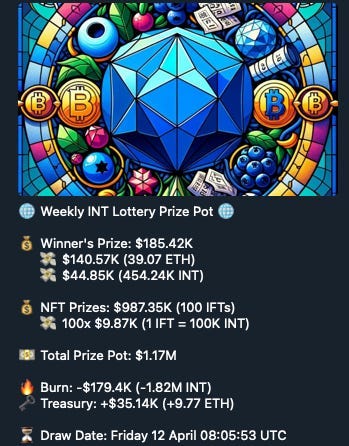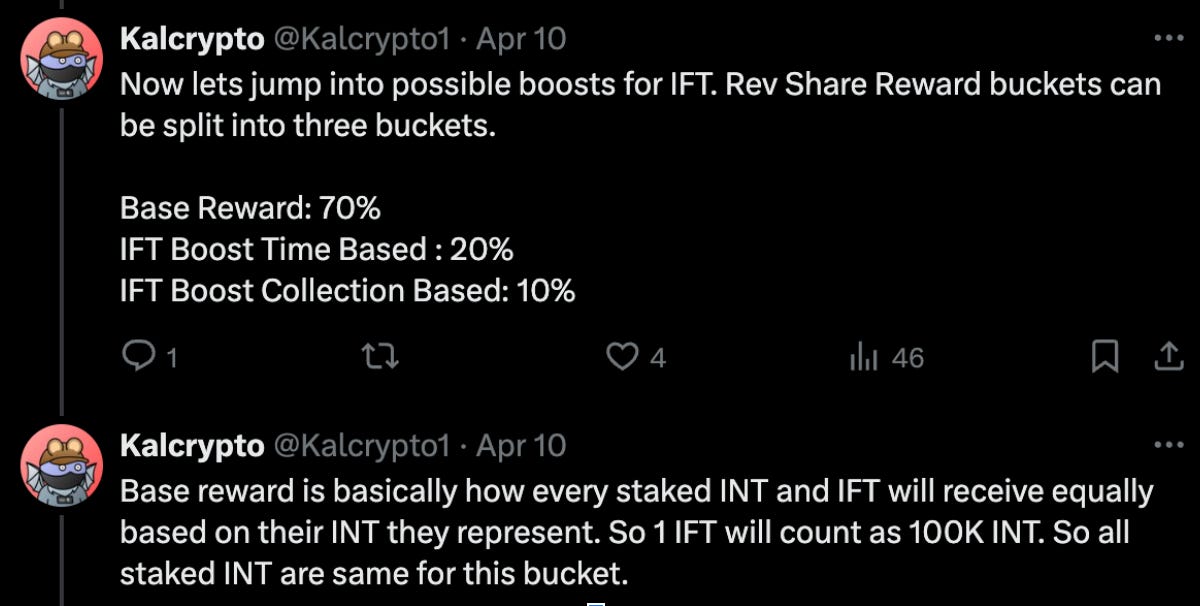Humans spend over $350 billion every year trying their luck on lotteries.
If you are in crypto, the chance is that you are a degenerate gambler!
This is nothing too unusual, as the thrill of gambling taps into a deep-rooted human desire for excitement through risk-taking.
The lottery market is projected to grow at a rate of 3.10% per year and reach over $400b by 2028.
Decentralized Gambling is one of the Sacred Grails of crypto. Many have tried and failed to innovate this sector.
Ultimately, why would you even have a niche for that when the whole crypto industry is basically a huge casino itself?
Among the most successful case studies within this space is Rollbit, which adapted the traditional casino business model and brought it to crypto.
What if there was a way to decentralize gambling at the application layer, starting with the creation of a self-sustaining and autonomous lottery?
Enter the Internet Token ($INT).
On Lotteries and Luck
Humans have been gamblers for thousands of years!
The earliest known reminiscence of a lottery dates back to around 200 BC, during the Han Dynasty in China.
However, the earliest records of a lottery with tickets for sale bring us back to Ancient Rome, carried by Roman Emperor Augustus. The lottery was used as an alternative for taxation, with funds used to repair the City of Rome.
Throughout history, lotteries have remained relatively unchanged compared to what we are used to nowadays: they are predominantly managed by state entities, with a few exceptions, and distribute about 57% of the funds they receive from ticket sales as lottery prizes.
But is there another model possible?
Can the lottery itself be autonomous and decentralized?
The Internet Token ($INT)
The Internet Token Protocol launched on Base on March 22nd, with no website or whitepaper, offering all necessary information directly within its smart contract:
https://basescan.org/address/0xdFd0bbFC8c188E923Bfb4fA5132C725d7D9c1988#code
The protocol's native token, INT, is a cryptocurrency that introduces a novel decentralized lottery model, where users can win prizes in INT, ETH, and other NFTs.
Every week, INT runs an autonomous and perpetual lottery.
The protocol uses its own liquidity as a marketplace for tickets, where users can buy and sell INT in order to get tickets.
The INT-WETH Uni V3 LP pool serves as the marketplace for tickets.
To get lottery tickets (Ticket NFTs), users can simply buy INT.
Users get 1 ticket by generating $5 in fees (every $500 in volume, with a fee of 1%)
Furthermore, holding INT also gives users governance rights in the project through the INT DAO.
Since inception, the project has attracted very strong traction, also due to the fact that the GMX dev X has been involved with this project — which translated into a strong influx of funds from GMX OGs
How does the INT lottery work?
Each INT trade made is subject to a 1% fee.
Every $5 worth of fees paid mints a Ticket NFT.
Every Friday, the protocol generates a verifiable random number selecting the winner of the prize through API3, an oracle provider.
The owner of the Ticket NFT with a matching ID receives a portion of the fees accumulated during the week: 80% of the fees accumulated in ETH and 20% of the fees accumulated in INT.
In addition, the protocol picks 100 NFT winners (“IFT”) every week. This number is halved every five weeks until 2000 IFTs are distributed out of 10,000 IFTs in total. Any user can burn the IFTs to redeem 1/10,000 of the INT supply.
To accumulate tickets, users are incentivized to buy and sell INT multiple times, which is reflected in the token's daily volumes (among the highest on Base).
Furthermore, the protocol also features an interesting burning mechanism, contributing to a positive flywheel.
Every week, after the lottery drawing, the remaining 80% of INT fees (only 20% is distributed as a lottery prize) are burned, reducing the INT token supply.
The more users participate in the lottery, the more volume and fees created, and the higher the prize. With a higher prize comes more participation, which results in more fees that burn INT tokens, making them more valuable.
The ultimate flywheel is here and running autonomously.
The model has been proven successful during the past three weeks, which have seen more volume and contributions and higher prizes.
This week, the prize pot was over $185k ($140k in ETH and $44k in INT), with almost $1m in IFTs (100 x $9.87k) and over $175k of INT burnt (about 1.8m or 0.18% of supply).
He’s Kingblockchain, realizing he won the weekly lottery; it must feel good!
However, you don’t need to be a big whale to try your luck, as the winner of the 2nd INT lottery only had 9 tickets!
The ticket sales are at an all-time high (ATH), with 33k tickets minted.
Volumes are also picking up, hitting ATH with an average of $6.8m over the last week, which is an insane volume considering the market cap of INT ($17m) and its novelty.
This all contributed to allowing the protocol to accumulate over 25 ETH to their DAO treasury.
The INT tokenomics is defined as follows:
As part of the tokenomics and another link to GMX, 10% of the supply of $INT can be minted using GMX, by burning the corresponding GMX.
This way, users can bond (and burn) their GMX to mint INT.
It’s worth noting also that the mechanisms introduced by the protocol to have deflationary tokenomics can prove to be a strong support for the price of INT, running independently of the direction of the market, and thus making INT less correlated with other tokens.
Taken from Kalcrypto:
Another pretty cool thing, even if the protocol gains more attention and say INT price goes up a lot it doesn’t affect the actual lottery gamblers cost to get a ticket. The cost to buy a ticket is still $5 ($10 if they don’t want to hold INT) This wouldn’t change no matter what price INT is trading at. In my opinion this is a very important innovation to decouple the lottery users from the price fluctuations of the INT token itself and keep the lottery accessible for everyone perpetually.
On IFTs
The definition of Infinity Collection (IFTs) NFTs can be found within the INT contract.
There is a total of 10000 IFTs.
20% of IFTs (2000) are set to be distributed by the DAO weekly, starting with 100 a week and halving every 5 weeks (for a total of 126 weeks).
As mentioned above, users can already decide whether to burn their NFTs for 1/10,000 of the INT supply or hold them for future utility.
The DAO is already discussing whether to commission the IFT art to a professional artist or whether to launch a small collection for OG holders.
Did anyone say revenue share?
IFTs have a time based boost, giving priority and more rewards to older NFTs:
The model brought forward by INT is particularly interesting due to its potential to redefine gambling. Creating a decentralized autonomous lottery is incredibly powerful and could potentially be one of the user cases of crypto.
I am sure we’ll see the same model expand to other industries. Instead of shifting from centralized to a decentralized casino, we’ll see the emergence of more and more games that are decentralized at the application layer and can run themselves.
Furthermore, creating autonomous and perpetual gambling products could also be a legal shield for protocols in the sector.
While the INT product is still in its infancy, with only 3 lotteries executed so far, it presents as a product with untapped potential, given the possible addressable market.
Creating more games leveraging the same system could add a flywheel effect to the INT tokenomics and create the first autonomous casino in DeFi.
The development of protocols like INT should be celebrated as the fulfillment of crypto's ethos of decentralizing every sector and disrupting incumbents, replacing them with autonomously running algorithms that can’t be tampered with.
For this reason, to me, INT assumes a bigger meaning, which hopefully will soon be extended to more applications/sectors to be disrupted.
I have never been a lucky person.
I have always preferred to bust my ass to earn what I want.
However… I am going for that fat decentralized autonomous lottery prize!
This is not a sponsored post - I hold INT, and I like the protocol.
My personal strategy to get some tickets is swing trade; however, the price has been going quite vertical.
I have noticed it’s a good strategy to sell before the lottery (usually on Fridays), as most people will do this to then buy back and get tickets, and the prize winners might sell.
I’ve seen others (you can check buys on Dexscreener) go full farming and buy and sell INT to farm tickets—hence the huge daily volumes.
For instance, this week, someone deployed a bot to farm an insane number of tickets, about 11k in total - spending over $100k in fees!
While they did not win the grand prize, they did win over 10 IFTs, which might be enough to cover their farming costs.
Here’s their address:
https://basescan.org/address/0x1B575b022AF4ABE78c1D984dF2DF6E8e14Ca7261#tokentxns
Anyway, these are just some ideas that should absolutely NOT be treated as financial advice, as I am a very bad trader, or I wouldn’t be here writing threads.
More on INT:
Kalcrypto is one of the first to talk about it:
https://twitter.com/kalcrypto1/status/1773278940607414473
https://twitter.com/kalcrypto1/status/1778164321287016818
https://twitter.com/insomniac_ac/status/1775095902241218917?t=8RGqfDyVWww7Gp8KcALvlg&s=19
Great article:
https://kalcrypto.substack.com/p/internet-tokenint
https://www.dlnews.com/articles/defi/internet-token-pays-24-million-in-prizes-since-march-22/?utm_source=twitter&utm_medium=organic_social&utm_campaign=
https://twitter.com/Internet_token/status/1776160356647223435



















